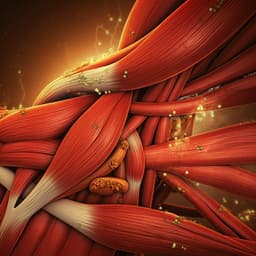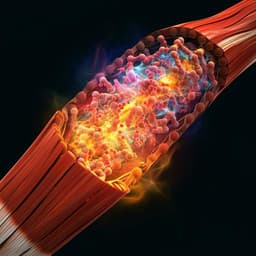
Medicine and Health
MOTS-c is an exercise-induced mitochondrial-encoded regulator of age-dependent physical decline and muscle homeostasis
J. C. Reynolds, R. W. Lai, et al.
This research reveals the exciting potential of mitochondrial-encoded MOTS-c in promoting physical performance and muscle health as we age. Conducted by a team of experts including Joseph C. Reynolds and Rochelle W. Lai, this study uncovers MOTS-c's ability to enhance exercise benefits and improve healthspan in mice, highlighting new therapeutic targets for combating age-related decline.
~3 min • Beginner • English
Introduction
The progressive loss of metabolic homeostasis is a hallmark of aging that diminishes physical capacity and increases risk for chronic disease. Mitochondria are central to cellular energy production and coordinate adaptive homeostasis through communication with the nucleus and other organelles. Beyond the 13 canonical protein-coding genes, the mitochondrial genome encodes short open reading frame peptides (mitochondrial-derived peptides, MDPs) with systemic physiological functions. MOTS-c (mitochondrial ORF of the 12S rRNA type-c) is an MDP that promotes metabolic homeostasis via AMPK and by regulating adaptive nuclear gene expression after nuclear translocation. MOTS-c levels are age-dependent and detected in multiple tissues and in circulation, prompting its designation as a mitokine. Prior work showed systemic MOTS-c reverses diet-induced obesity and insulin resistance in mice. Given the age-related decline in physical capacity and the role of mitochondrial signaling in exercise adaptations, the authors hypothesized that MOTS-c functions as a mitochondrial-encoded regulator of physical capacity and performance across age. Here, they show that exercise induces mtDNA-encoded MOTS-c expression in humans, and that exogenous MOTS-c improves physical performance in mice of different ages, regulates skeletal muscle metabolism and gene expression, and enhances cellular adaptation to metabolic stress.
Literature Review
Background literature highlights that aging involves loss of metabolic homeostasis and reduced physical capacity, with mitochondria implicated at multiple levels in aging and stress responses. Mitochondrial-derived peptides (MDPs) encoded by mitochondrial sORFs, including MOTS-c, have emerged as bioactive regulators of metabolism. Previous studies showed MOTS-c activates AMPK signaling, increases GLUT4 expression in muscle, translocates to the nucleus under metabolic stress to regulate nuclear gene expression, and improves metabolic parameters such as obesity- and age-related insulin resistance in mice. MOTS-c is present in tissues and circulation with age-dependent expression and has been proposed as a mitokine. Exercise is known to induce adaptive responses in skeletal muscle involving metabolic, oxidative, and heat stress pathways, with HSF1 as a master regulator of proteostasis and stress responses. This context sets the stage to test whether a mitochondrial-encoded peptide can modulate physical capacity and aspects of healthy aging.
Methodology
Human study: Ten sedentary healthy young males (24.5 ± 3.7 years; BMI 24.1 ± 2.1) completed a two-visit protocol. Visit 1 determined VO2peak using a ramp cycling test. Visit 2 entailed high-intensity interval cycling (10 × 60 s intervals at peak power, 75 s rest). Plasma samples were collected at rest, mid-exercise (after 5th interval), immediately post-exercise, and after 4 h recovery; vastus lateralis biopsies were obtained pre-, immediately post-exercise (~5 min), and after 4 h recovery. Skeletal muscle MOTS-c protein was measured by Western blot; plasma MOTS-c by ELISA.
Mouse studies: Male mice were used. Young cohorts included 12-week-old CD-1 (outbred) and C57BL/6J (inbred) mice; middle-aged and old cohorts were C57BL/6N mice initiated at 12 and 22 months of age, respectively. Mice were housed under 12:12 h light-dark at 24°C with ad libitum food/water. Diets: control or high-fat diet (60% kcal fat). MOTS-c peptide (New England Peptide) was administered intraperitoneally at 5 or 15 mg/kg/day. For acute performance studies, daily injections were given for 2 weeks; for late-life initiated intermittent (LLII) regimen, mice received 15 mg/kg three times weekly starting at ~23.5 months. Body weight and food intake were recorded; body composition assessed by time-domain NMR (Bruker minispec) twice weekly.
Physical performance assays: Treadmill protocol included acclimation, training (10 m/min × 20 min on two non-consecutive days), and a graded test with stages: 5 min at 13 m/min; then +1 m/min for 5 min; then 30 min at 18 m/min; after 40 min, speed increased to 23 m/min until exhaustion. Exhaustion defined as remaining on the platform >30 s despite prodding. Rotarod: accelerating from 24 rpm, +1 rpm every 10 s; time to fall recorded (3 trials). Grip strength: forelimb horizontal bar trials (3 trials). Gait: inked paw prints with stride length measured (average of three strides). For 30-month-old mice, a 60-s walking test at 13 m/min was used (pass/fail criterion). Metabolic cages (PhenoMaster) measured VO2, VCO2, RER, food and water intake, and activity over 36 h.
Molecular analyses: Targeted metabolomics of skeletal muscle and liver used LC–MS on a Q-Exactive Plus with NH2 column; pathway enrichment via PCA loadings and KEGG MSEA. RNA-seq: rRNA-depleted, strand-specific libraries sequenced (PE150) on Illumina HiSeq X Ten; reads trimmed and quantified with kallisto; analyses performed in R with DESeq2; surrogate variable analysis (sva) used for muscle; GSEA via clusterProfiler with KEGG and GO_BP; ChEA used for TF enrichment.
Cell culture: C2C12 myoblasts cultured in DMEM (4.5 g/L glucose) with 10% FBS. Metabolic stress conditions included glucose restriction (0.5 g/L) and serum deprivation (1% FBS) for 48 h or 7 days; complete glucose restriction (0 g/L) with chemically defined lipid mixture supplementation tested lipid utilization reliance. MOTS-c (10 µM) was added once or daily as specified. Cell survival and proliferative capacity assessed by crystal violet staining; flow cytometry used in some assays. Seahorse XF96 measured oxygen consumption rate (OCR) and ECAR in response to palmitate-BSA vs BSA. Confocal microscopy tracked FITC-labeled MOTS-c nuclear translocation over time. siRNA-mediated HSF1 knockdown tested the requirement for HSF1 in MOTS-c protective effects under GR/SD.
Statistics: Data expressed as mean ± SEM. Two-sided Student’s t tests for most comparisons; log-rank (Mantel–Cox) for survival and running curves; two-way repeated-measures ANOVA for some RER analyses. Significance thresholds denoted by P values or *, **, ***.
Key Findings
Human exercise: Skeletal muscle MOTS-c protein increased 11.9-fold post-exercise and remained elevated after 4 h (Western blot; n=10; P=0.0098 for relative change). Plasma MOTS-c increased during exercise by 1.6-fold and post-exercise by 1.5-fold, returning to baseline after 4 h (ELISA; n=10; P=0.0011 and P=0.0021).
Young mice performance: In CD-1 mice on normal diet treated with MOTS-c for 2 weeks, treadmill performance improved dose-dependently (15 mg/kg): increased total time (P=0.0069 vs control; P=0.0081 vs 5 mg/kg), distance (P=0.0418 vs control; P=0.0081 vs 5 mg/kg), and 100% reached sprint stage vs 16.6% in control and 5 mg/kg. Rotarod performance improved; grip strength and Barnes maze memory were unchanged. Under HFD, high-dose MOTS-c (15 mg/kg) for 10 days significantly improved running capacity and total work (joules). Body composition showed reduced fat gain at both doses and increased lean mass at 15 mg/kg; performance improvements were independent of body weight (no correlation with running time).
C57BL/6J on HFD or control diet: After 2 weeks of diet lead-in + 2 weeks of MOTS-c (15 mg/kg), treadmill time and distance increased regardless of diet (time P=0.0237 control diet; P=0.0084 HFD; distance P=0.0326 control diet; P=0.0087 HFD). On control diet + MOTS-c, 25% reached the sprint stage vs 0% on HFD + MOTS-c. MOTS-c reduced HFD-induced weight gain by lowering fat mass without reducing lean mass; food intake unchanged. Targeted metabolomics indicated regulation of glycolysis/PPP and amino acid metabolism in skeletal muscle (not liver).
Old mice performance and metabolism: In C57BL/6N, 2 weeks of MOTS-c (15 mg/kg/day) improved treadmill running in middle-aged and old mice (running curve P=4.6E-8). Old mice ran 2.0× longer and 2.16× farther; 17% reached the highest speed vs 0% controls. RER analysis showed age-related loss of metabolic flexibility (reduced day-night shift) restored by MOTS-c, aligning old mice RER rhythms with middle-aged patterns. Metabolomics of exercised skeletal muscle after MOTS-c indicated regulation of glycolysis and amino acid metabolism; non-exercised muscles showed minimal changes, suggesting exercise-dependent metabolic adaptation. RNA-seq GSEA indicated enrichment of metabolism (AMPK signaling, glycolysis, central carbon metabolism) and longevity-related pathways; GO_BP highlighted lipid/carbohydrate/amino acid/nucleotide metabolism, oxidative stress response, immune response, and nuclear transport.
Late-life intermittent MOTS-c (LLII): Initiated at ~23.5 months (3×/week, 15 mg/kg), LLII improved late-life physical function: higher grip strength (n=11; P=7.8E-5), longer stride length (n=5; P=0.0038), and better 60-s walking test performance (P=0.0428). Non-fasting blood glucose at 30 mo was better maintained (P=0.0397). Across life, body weight sums were lower with MOTS-c (both MA and old cohorts significant), total food intake was significantly reduced while total activity increased. Body composition: markedly reduced fat mass (P<1E-50) and modest preservation of lean mass (significant in summed analyses). RER at 30 mo indicated increased fat utilization, consistent with reduced adiposity. Survival trended upward: median lifespan +6.4%, maximum +7.0%, hazard ratio 0.654; significant difference up to 31.8 months (P=0.05); overall curve not significant (P=0.23), indicating a trend toward increased healthspan and potential compression of morbidity.
In vitro C2C12 adaptations: Under GR/SD (48 h), a single initial 10 µM MOTS-c treatment doubled survival (P=2.57E-25). After 7-day GR/SD with daily MOTS-c followed by 2-day recovery in full media, proliferative capacity increased ~6-fold (P=8.95E-22). Under complete glucose restriction with lipid supplementation, MOTS-c conferred ~2× protection (P=1.17E-09). MOTS-c increased lipid oxidation capacity (OCR) in response to palmitate (P=6.27E-07) without increasing ECAR. FITC-MOTS-c translocated to the nucleus in a time-dependent manner. RNA-seq under GR/SD identified 69 DE genes (FDR<5%), including heat shock response components (Hsp40/DNAJ, Hsp70/HSPA) and known MOTS-c targets (Atf3, Jun, Fosl1, Mafg). GO_BP indicated proteostasis pathways (protein folding) as prominently affected; overlay with in vivo muscle RNA-seq revealed common proteostasis and stress-related pathways. ChEA TF enrichment implicated HSF1 in both models; siRNA HSF1 knockdown abrogated MOTS-c protection under GR/SD, establishing HSF1 dependence.
Discussion
The study addresses whether a mitochondrial-encoded peptide actively regulates physical capacity and aspects of aging. Findings demonstrate that MOTS-c is exercise-inducible in humans and that exogenous MOTS-c improves performance across young, middle-aged, and old mice, independent of body weight. Mechanistically, MOTS-c remodels skeletal muscle metabolism (glycolysis/PPP, amino acids) and enhances metabolic flexibility, as evidenced by restored circadian RER dynamics in old mice. Transcriptomic analyses reveal regulation of metabolic and longevity pathways, and proteostasis processes, aligning with MOTS-c’s known AMPK dependence and nuclear gene regulation. In vitro, MOTS-c promotes survival and recovery from metabolic stress, increases lipid oxidation capacity, and requires HSF1, a master regulator of stress adaptation and proteostasis, suggesting a mitochondria-to-nucleus signaling axis that supports muscle adaptation to exercise-like stress. Late-life intermittent treatment enhances multiple functional measures of healthspan, reduces adiposity, shifts substrate utilization toward fat, and trends toward increased survival, indicating potential compression of morbidity. Collectively, the data support a bi-genomic framework for aging regulation, where mitochondrial-encoded signals such as MOTS-c coordinate with nuclear programs to sustain muscle function and systemic metabolic health.
Conclusion
MOTS-c is an exercise-inducible, mitochondrial-encoded peptide that enhances physical capacity in mice across ages, regulates skeletal muscle metabolism and nuclear gene expression, and promotes cellular adaptation to metabolic stress via HSF1-dependent pathways. Late-life intermittent MOTS-c improves healthspan metrics (strength, gait, mobility), favors fat utilization, reduces adiposity, and trends toward increased lifespan, suggesting a role in compressing morbidity. These findings position the mitochondrial genome as a source of modulators of aging and physical performance. Future work should include larger lifespan cohorts to confirm longevity effects, delineation of MOTS-c uptake mechanisms and receptor(s), detailed mapping of its nuclear gene targets, sex-specific responses, and translational studies to assess efficacy and safety in humans.
Limitations
RNA-seq from old mouse muscle exhibited high inter-individual variability, necessitating surrogate variable analysis. Lifespan benefits in the late-life intermittent treatment arm showed only a trend overall (significant until 31.8 months), indicating the need for larger cohorts to establish longevity effects. Human data were limited to a small sample of young sedentary males (n=10) and did not assess functional performance outcomes. Most mouse experiments used males, limiting generalizability across sexes. RER and metabolic outcomes may be influenced by circadian feeding behavior. The mechanistic details of MOTS-c cellular uptake and endocrine signaling remain to be fully resolved.
Related Publications
Explore these studies to deepen your understanding of the subject.







